New eCommerce businesses emerge every day, but only some of them start with a customer-centric approach in mind. We’re talking about the real meaning of customer-centricity – the one that helps you focus on customer behavior and emotions to generate better experiences and improved business results.
Customer-centricity sounds so good in theory, but many companies fail to put it into action. It calls for some major changes across the company, and you need to have everyone on board. We identified 14 tactics that help your eCommerce store become more customer-centric.
Monitor what matters
Most of the eCommerce companies that struggle use only the default eCommerce Flywheel.
The leaders are also using the advanced one.
Any healthy eCommerce store relies on the advanced flywheel. To keep this flywheel spinning, you need to nail customer acquisition and retention.
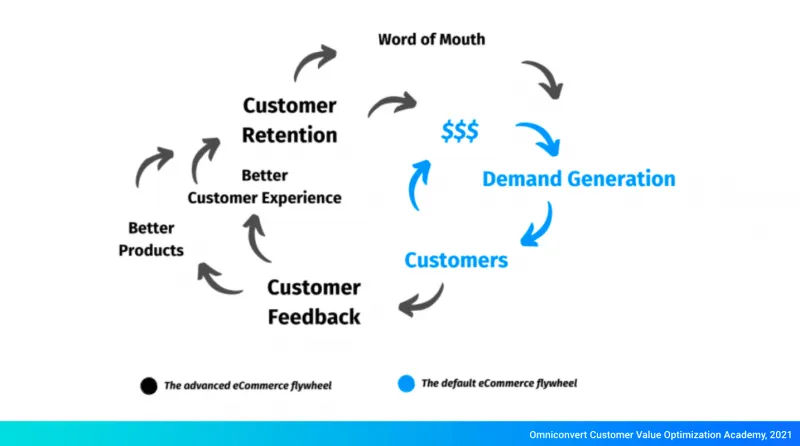
With so much data available from different sources, it can be challenging to concentrate only on what matters most for your business.
You’ll settle more easily over your top KPIs if you keep the flywheel in mind and the possible scenarios for your business.
- Track how many active/lost customers you have
Track customer behavior, cohorts of newly acquired customers, check how they behave throughout the time, and drill down as segment or individual level to understand the causes behind the numbers.
- Monitor Customer Lifetime Value (CLV)
How much can you expect to get from a newly acquired customer? What is the customer lifespan? Is CLV trending upwards or not? You need to answer all of these questions.
- Know how happy are your customers (NPS)
Monitor NPS by RFM segment, order attribute, brand, customer support rep, discount code. Be sure to check the “delivery gap.” How? Monitor the NPS before and after the delivery.
- Keep an eye on customer retention
Habit-forming is a vital component for eCommerce businesses in a lot of verticals. Monitor customer retention metrics like purchase frequency, orders per customer, and average days between transactions.
- How profitable is your eCommerce
Monitor the Net Margin, its trend, and segments that contribute the most at the margin, understanding which customers you should be focusing on next.
- Monitor the North Star Metrics
Every investor will be interested in the ratio between CLV and CAC. The ratio accurately represents if the company is going in the right direction or not.
As Valentin Radu, CEO of Omniconvert, said, an eCommerce founder has only three routes:
- Sell the company;
- Grow the company;
- Milk the company.
What’s common for all scenarios? The importance of CLV to CAC ratio, Valentin shows:
“If you’re in the A-scenario, think of your company as a product that you craft to eventually sell. That means you must keep an eye on your North Star metric: CLV/CAC – that’s what a strategic and financial investor will use to evaluate your product.
If you’re in the B scenario, you need to decide over bootstrapping or getting external investment. To get it, though, you must understand that profit solves all the problems. That means you must show either accelerated growth either an incredible margin.
Those are reached ONLY if you are aware of the CLV/CAC ratio.
If you’re in the C scenario, you have to delight customers. The eCommerce flywheel involves Acquisition > Over-delivery > Retention > Word of Mouth > Growth.
So you must keep an eye on CLV/CAC.
No matter the scenarios, you risk a lot by guiding yourself by visitor behavior in GA or by financial metrics in your P&L.
The only solution that’s not to the benefit of advertisers to recommend is to keep an eye on customer behavior.”
Segment customers based on the RFM model
Effective customer-centric strategy starts with segmentation. RFM segmentation is a great method for identifying the most important customers by grouping them according to their scores for recency, frequency & monetary values.
That allows you to target specific customer clusters with more relevance for their particular behavior – and thus generating higher rates of response, increased loyalty, and better customer lifetime value. A customer intelligence platform that allows you to perform RFM segmentation automatically will simplify things considerably.
Do you have a lot of Ex-Lovers, like the company in the image below? It means that you lost many valuable customers that used to purchase frequently and spend a good amount of money on your offers. Most people end in the Ex-Lover segment due to poor customer experience. To learn more about each segment, check out our simple guide on RFM Segmentation.
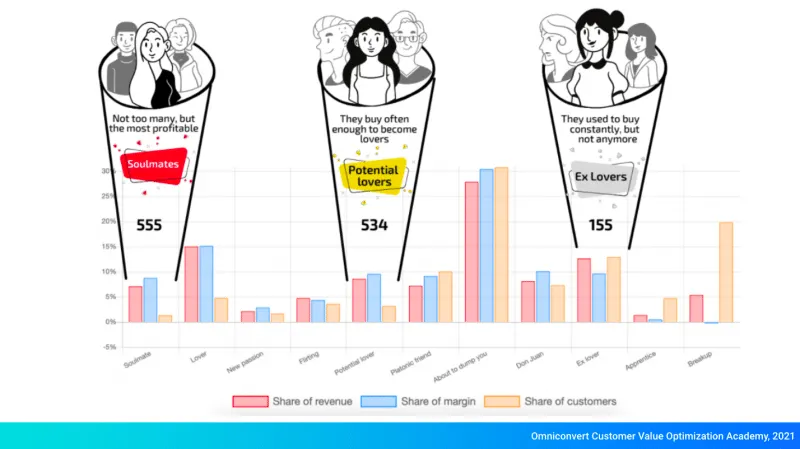
Understand your Ideal Customer Profile (ICP)
Not all customers are created equal. Any eCommerce company has great customers, OK-ish customers, and bad customers.
By analyzing your customer data, you can understand who your ideal customers are, identify their particularities, and how to keep them loyal in the long run.
We’re calling your ideal customers “Soulmates.” Thanks to real-time segmentation tools, you can identify and monitor the soulmates dynamically.
Analyzing their needs, challenges, motivations, and behavior will help you:
- Attract more customers like them;
- Retain more of them;
- Optimize the product assortment.
Find the Jobs To Be Done for your store/products
Understand your product’s jobs to improve your positioning, acquisition, and retention.
Through Jobs To Be Done interviews, you’ll understand what makes your customers buy, continue to buy, and recommend your product.
Knowing the motivations behind your best & active customers who buy a particular product will allow you to find the Jobs To Be Done for your store (traditional retailers) & products (DTC) and communicate them across all lifecycle stages.
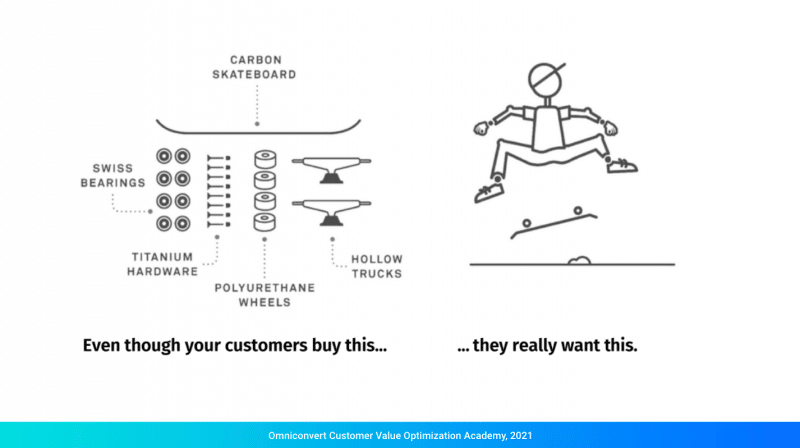
Qualitative Research
Qualitative research helps you identify the underlying problems behind data and unveil the hidden causes that stop customers from returning and your company from growing.
With an automated RFM segmentation tool, you will be able to collect qualitative data according to each customer segment so that you can improve the most important aspects of your customer journey.
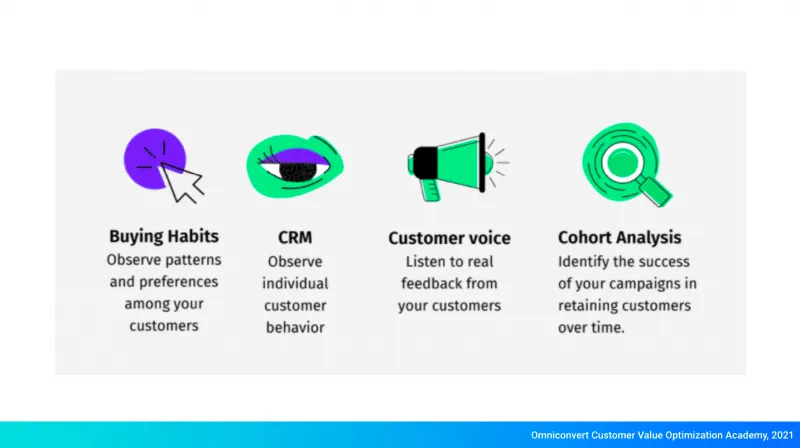
Measure and monitor Net Promoter Score (NPS)
The Net Promoter Score reflects how likely your customers are to recommend your brand to friends and family. To have an accurate representation of customer experience, you need to measure NPS before and after delivery.
Measuring and monitoring NPS in real-time allows you to automate immediate actions based on data, improving customer support and the customer experiences across all segments.
For a deeper understanding of customer sentiment, analyze NPS from different angles:
- Pre-delivery NPS versus post-delivery NPS
- NPS by RFM segment
- NPS by Location
- NPS by Brand
- NPS by Category
- NPS by Channel
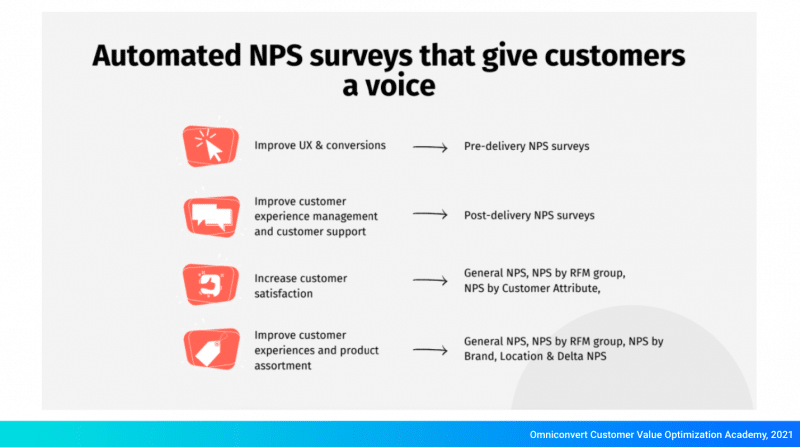
Map the customer journey
Mapping the customer journey is your road to empathy. Understanding your customers helps you design a journey that transforms your products into solutions for their motivations and struggles.
Your products become part of their lifestyle.
Different segments imply a different journey. Draw the Customer Journey Mapping for all the segments of your customer base.
The outcome?
Deliver the most relevant treatment to each customer segment based on the relationship you’ve established and their current expectations at every touchpoint.
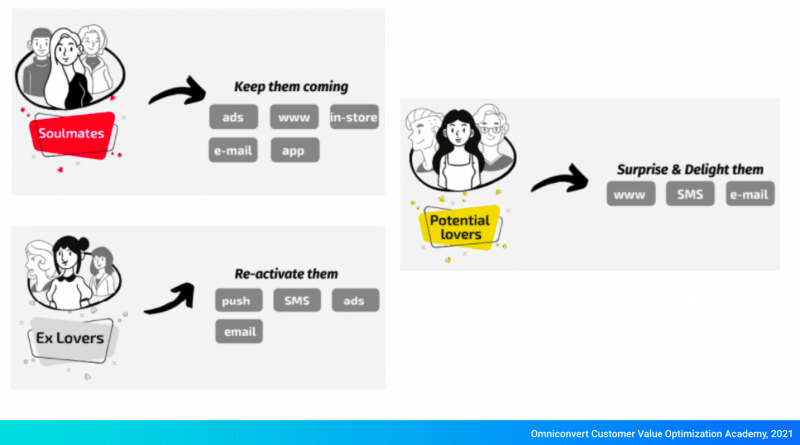
Improve customer acquisition
If you want to improve customer acquisition, you have to attract more customers like the best ones.
Having all the first and zero-party data about your customers at your fingertips means that you can attract, convert, and retain more people like your most valuable customers.
Use existing data to create better messaging and offers for new audiences and gain more customers like those from your most valuable segments.
You can create lookalike audiences for your paid ad efforts based on your best customers. This tactic helps you feed the ad algorithms and generate customers that will stick around, not just the average customers. Identify product affinities to create the best offers for each segment.
Enhance your email marketing efforts
To generate engagement and revenue from this channel, you need to push valuable data towards your email marketing platforms.
Integrating RFM segmentation and NPS tools with Klaviyo and Sendgrid allows you to push data to improve all processes enabled through email marketing.
The power of integration goes beyond the ability to send NPS surveys:
- Designing better nurturing campaigns based on email segmentation;
- Adding new personalization elements based on customer tags;
- Sending automated emails based on specific behaviors to anticipate their next moves.

Personalize the customer experience on your website
Personalizing customers’ experiences throughout your website by using RFM segments makes it easier than ever to use the best practices from traditional retail and add a human touch to online experiences.
Make your website relevant to each customer:
- Concierge services: treat your best customers better – remind them what benefits they get thanks to how special they are to your company;
- Deflate the ticking-bombs: you can offer a welcome-back special offer to any customer that had a bad experience (based on their last NPS score);
- Personalize the landing pages they see by suggesting complementary products & offers based on their purchase history.
Design customer loyalty programs
To tell a story that resonates with your customers, you need to discover insights about what generates loyalty.
Analyze your customer behavior, and you’ll find all the information you need to design unique
loyalty programs based on shared values and on offers that resonate with your customers.
Look in customer behavior reports like:
- Customer Retention;
- Customer Voice;
- Buying Habits;
- Cohort Analysis.
Optimize the product assortment
It is helpful to see your bestselling products, but it’s more helpful to know if they generate higher loyalty or higher customer churn.
To boost sales in online shopping and Customer Lifetime Value at the same time, you have to:
- Filter your best and worst-performing products by how present they are in the purchase history across all customer segments.
- Identify your toxic products and best products by knowing how these affect customer retention.
Know precisely which items are churning customers and which generate loyalty with insight from product performance reports:
- Order Returns
- Buying Habits
- Net Promoter Score
- Margin
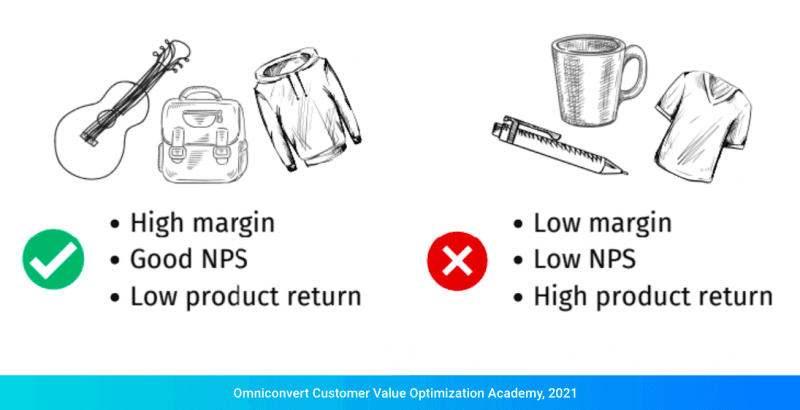
Treat your best customers better
The “under-promise, over-deliver” principle should guide any customer-related initiative. Understand early on which customers are more promising so you can automate different treatments for different customer segments.
This way, you’re investing your resources towards your most valuable segments. Find new ways to keep the most valuable customers close and happy.
They deserve VIP treatment:
- Appreciation calls
- Exclusive offers and content
- Thank you notes and presents in the delivery package
- Personalized product recommendations and website experience
Perform Cohort A/B testing
Cohort A/B testing helps you analyze if your marketing efforts support your customer-centric approach and design the most effective onboarding for each customer type.
Your first-time customers can be split into two groups based on their RFM scores and treated differently from the thank-you page to the emails, remarketing ads, and to the packaging directions in fulfillment.
A cohort analysis tool allows you to do this insightful research and track the 2nd-month cohort stickiness rate to identify the best method to make new customers buy again.
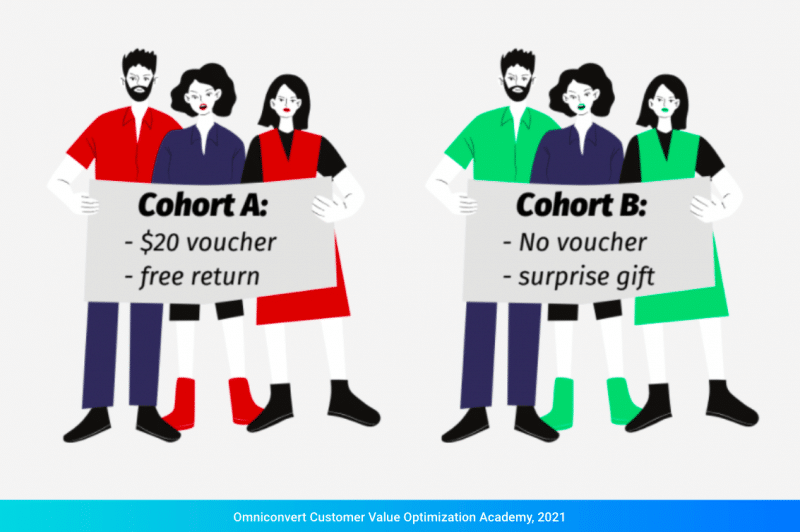
The different approach in business is often reflected in the tools companies use to measure, monitor, and analyze data.
You want your customer-centric tactics to be successful, so you need the right tools to support eCommerce innovation and goals like seamless customer experiences enhanced by email marketing, personalized shopping experiences via website or store’s app, and so on.
Tools like RFM Segmentation and integrations with other platforms in your ecosystem become vital for a customer-centric company. Such tools give you more time to focus on strategy and new campaigns ideas rather than on repetitive, tiring tasks as data aggregation or monthly reporting by gathering data from different sources into one Excel sheet.
Prepare for the future of eCommerce and be smarter about your goals. Choose the tools that allow you to achieve customer-centricity.
Frequently asked questions about Customer centric eCommerce
What is a customer-centric ecommerce approach?
A customer-centric ecommerce approach is a business strategy that prioritizes the needs, preferences, and overall experience of the customer. It focuses on understanding customer behavior, delivering personalized interactions, and providing seamless and delightful experiences throughout the entire customer journey.
Why is a customer-centric ecommerce approach important?
A customer-centric ecommerce approach is important for several reasons: Customer satisfaction and loyalty, Competitive advantage, Increased customer lifetime value, Personalization and relevance. A customer-centric approach allows businesses to deliver personalized experiences tailored to individual customer preferences. This creates a sense of relevance, increases engagement, and drives conversions.
What are the benefits of a customer-centric ecommerce approach?
Some benefits of a customer-centric ecommerce approach include: Increased customer satisfaction, Repeat purchases and higher retention, Positive word-of-mouth and referrals, Improved brand reputation and Competitive differentiation.
By embracing a customer-centric ecommerce approach, businesses can create a positive and engaging experience that builds lasting customer relationships and drives business success.
